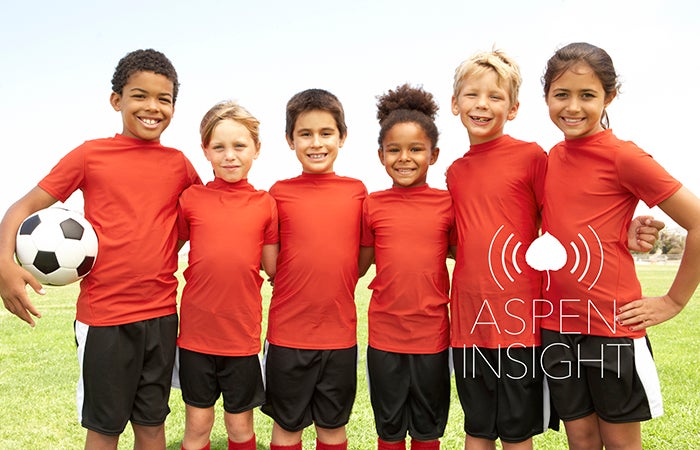She wears pink Under Armour high-top sneakers with purple flair, a sporty Boathouse jacket from her lacrosse team layered over a bright pink hoodie, and shiny stud earrings shaped like footballs. As she carries her stuffed zebra around town with her, nine-year-old Chloe Patrone is the embodiment of a girl athlete in the year 2019.
Patrone has strong convictions and interests, and she loves a good challenge. Her coach calls her “freakishly strong”; on the football field, she can keep up with the other girls—and, often, the boys.
For centuries, people saw sports as the domain of boys and men, but today it is a pastime and passion of children and adults of all genders. And while girls and women continue to pursue equal funding and opportunity, today’s societal trends favor a more nuanced understanding of gender, leading to a new question: Should athletes of all genders play together on the same field?
At the elite level, some sports, like tennis and figure skating, have long introduced mixed-gender competitions. And in the past decade, that trend has expanded to include the Olympic Games. The international governing bodies for swimming, track and field, and triathlon have all hosted mixed-gender relays since at least 2015, and these sports will make their mixed-gender Olympic debuts in Tokyo next summer. “We have taken a really important step forward in terms of gender equality,” says Kit McConnell, the sports director for the International Olympic Committee, which must approve any changes to the games.
From a participation perspective, mixed-gender events open the door for more women to compete in the Olympics—a relative advance, as an equal number of male athletes will also gain entry. The social message and optics, however, couldn’t be better: athletes of both genders must work together to reach the top of the podium. “We’re taught to define our athletic selves in opposition to something, and gender is an easy one,” says Joe Maloy, who won the mixed-gender triathlon World Championships for Team USA in 2016. “The statement that we make as a team going out there … and doing it together as equals is the big message of mixed-gender triathlon relays.” Such sports, and the relay format, create an opportunity for mixed-gender events, eliminating potentially controversial obstacles such as physical contact, close proximity, or even simultaneous competition.
Of course, not every sport lends itself to mixed-gender contests. In popular sports like soccer, basketball, and tackle football, there are legitimate barriers to gender equity at the highest levels. “Physics comes into play,” US soccer legend Kristine Lilly says. “Guys are a little bit stronger and faster.” But Lilly adds, the skills, tactics, and mind-set are the same regardless of gender.
Plus, as all good athletes know, where there’s a will, there’s a way. Bobsled, for example, reclassified its “four-man” event as “gender neutral” in 2014. Elana Meyers Taylor, who successfully lobbied for the event, became the first American woman in recent history to pilot a four-man bobsled. She says that for mixed-gender sports to be really successful, both sides need to want it to work. “It really is a collaborative effort for both genders to accept it,” Taylor says, “and be each other’s champion.”
When they do, there are great payoffs—on and off the field. Researchers at Texas A&M University, for example, studied college quidditch, the human version of the sport made famous in Harry Potter. Thanks to the sport’s Title 9¾ (a pun that refers to the real Title IX gender-equity law and to Harry Potter’s fictional train-station platform), quidditch is the only fully mixed-gender, full-contact sport in the United States. The college quidditch athletes reported a positive change in attitude toward the opposite gender, and women reported increased confidence as a result of the sport.
But what about young kids like Chloe Patrone? The Women’s Sports Foundation says that before puberty, “there is no gender-based physiological reason to separate” the sexes in sports. Though there’s no national data about the prevalence of mixed-gender sports, there has been an uptick in a few sports. In the past decade, the number of high-school girls who wrestle has more than tripled, many of them competing with and against boys. The growth of flag football has also opened that sport to girls, as it has for Patrone.
“It’s so cool to play with boys,” Patrone says. On her flag-football team, Patrone’s male peers are simply her teammates and friends. It’s not any different from her all-girls teams, which she also loves (except for the lacrosse skirt she sometimes has to wear). However, the on-field dynamics can be different. Patrone’s flag-football team sometimes plays against all-boys teams who can be quick to put her down. That’s in contrast to the boys on opposing mixed-gender teams, who don’t insult her. Luckily, her teammates have her back. And when she plays on her all-girls sports teams, the girls playfully “talk smack,” but it’s never about gender.
Even as mixed-gender opportunities grow, questions remain. How do you recruit boys and girls, or men and women, in equal numbers? How do you keep the games fair and safe? How do you avoid perpetuating gender stereotypes? Can mixed-gender sports be a safer place for LGBQ, transgender, or gender-nonbinary athletes?
Still, there’s at least one question athletes in mixed-gender leagues don’t have to answer: athlete gender. “Our goal is to create lifelong athletes, deliver fun, and help kids build positive relationships,” says Carl Ehrlich, the founder of Flag Star, a youth flag-football league, and the former captain of the Harvard flag-football team. “Nothing about that is gender specific.”
